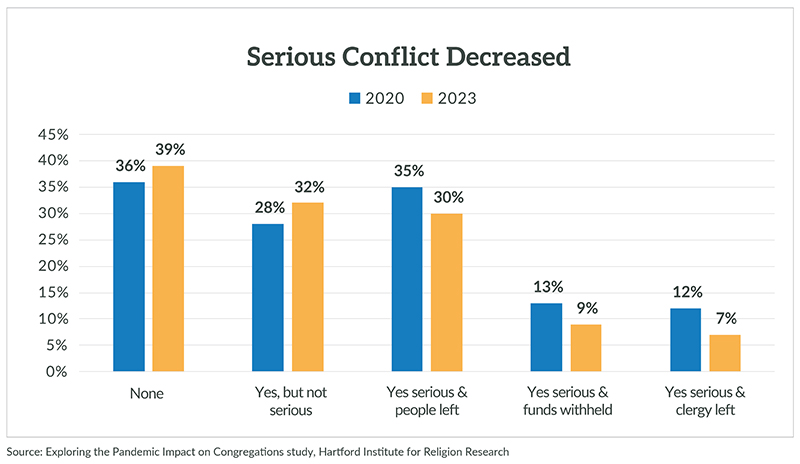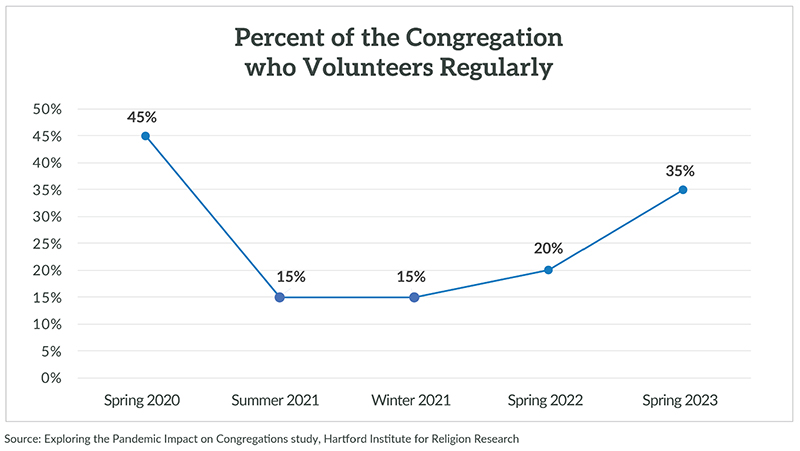Despite the boost from online donors, the return to in-person worship appears to play a role in increased giving. In congregations where there are more virtual worshippers than in-person worshippers, the median per capita giving was $1,053. In congregations where most of the attendees are in person and few are virtual, giving was $2,479 per capita.
“Whatever the reasons for the rise, it will be interesting to watch this trend in future surveys,” researchers wrote. “This is especially true since the growth in income did not translate into a significantly more positive assessment of the congregation’s financial health compared to their self-perception of five years earlier.”
Giving to religious groups — including congregations and other faith-based charities — grew by 5.2% in 2022, according to the Giving USA report. Those donations made up about a quarter (27%) of all giving to charity — and religion was the only sector in the Giving USA report where giving went up.
“Percent of the Congregation who Volunteers Regularly” Graphic courtesy of HIRR
While online worship persists, other forms of activities — such as youth programs, adult education and prayer groups — that were held online during the pandemic are now mostly in person.
“Half of churches are not holding any small groups or Bible studies online, 40% do not use online platforms for their administrative and committee meetings, and 40% have no e-newsletter,” according to the report.
In other findings, volunteerism is bouncing back, with congregations reporting that a third (35%) of their members volunteer regularly, up from 15% in 2021 and 20% in 2022. That number, however, does not match the 45% who volunteered in 2020.
Conflict at congregations has also declined, with 7% reporting that conflict was so serious that clergy left, 9% saying people withheld funds due to conflict and 30% saying people left due to serious conflict. In 2020, 12% of congregations reported that clergy left due to conflict, 13% said people withheld funds due to conflict, and 35% said people left.
Thirty-nine percent said there was no serious conflict in 2023, up from 36% in 2020, while 32% said there was conflict but it was not serious, up from 28% in 2020.

“Serious Conflict Decreased” Graphic courtesy of HIRR
Almost half of congregations (45%) said they were very positive about the future, while a third (36%) were somewhat positive. Nine percent were somewhat negative and only 2% said they were very negative.
However, the percentage of clergy who have thought about leaving both their church and the ministry altogether has risen since 2020.
In 2021, most clergy in the survey (79%) said they had never thought about leaving their current church, while 13% said they thought often about leaving. In 2023, the number who never thought about leaving had dropped to 62%, while 29% said they thought about it often.
As for leaving the ministry altogether, two-thirds of clergy (62%) said in 2021 that they had never thought about doing so, while 27% said they thought about it often. In 2023, 49% said they never thought about leaving, while a third (34%) have thought about it often.
Congregations also have less enthusiasm for change, three years after the start of the pandemic. In the summer of 2021, 86% of congregations said they were willing to embrace change in order to meet their challeges— including 47% who strongly agreed that they were willing to change. In 2023, two-thirds (66%) were willing to change — with only 20% strongly agreeing.
Researchers said congregations appear to be hopeful that they can face the challenges ahead of them. But those challenges are significant.
“Amid these positive signs remain some structural and organizational challenges that indicate all is not entirely rosy. Even given the rebounding attendance and level of optimism, the broad pattern of considerable membership decline remains ever-present.”
This article originally appeared here.


